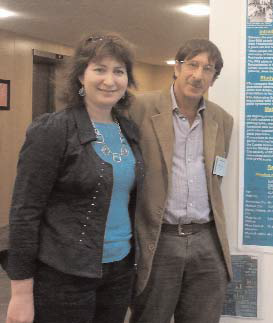Living With Polio
Post-Polio in Jerusalem (2012)
PHI awarded $25,000 to the Hadassah Medical Center in Jerusalem.
 The 2011 study was called Characteristics of poliomyelitis and post-polio patients among Jews and Arabs in Jerusalem under the leadership of Zeev Meiner, MD, Principal Investigator, Department of Physical Medicine and Rehabilitation, Hadassah Medical Center, Jerusalem, Israel. Dr. Meiner’s co-investigators included Isabella Schwartz, MD, Head of the Department of Physical Medicine and Rehabilitation, Hadassah Medical Center; Irina Gartsman, MD, Department of Physical Medicine and Rehabilitation, Hadassah Medical Center; Yechiel Friedlander, PhD, The Hebrew University-Hadassah, Braun School of Public Health – Biostatistics and Epidemiology; and Orly Manor, PhD, Head of Braun School of Public Health, The Hebrew University–Hadassah Medical Center, Biostatistics and Epidemiology.
The 2011 study was called Characteristics of poliomyelitis and post-polio patients among Jews and Arabs in Jerusalem under the leadership of Zeev Meiner, MD, Principal Investigator, Department of Physical Medicine and Rehabilitation, Hadassah Medical Center, Jerusalem, Israel. Dr. Meiner’s co-investigators included Isabella Schwartz, MD, Head of the Department of Physical Medicine and Rehabilitation, Hadassah Medical Center; Irina Gartsman, MD, Department of Physical Medicine and Rehabilitation, Hadassah Medical Center; Yechiel Friedlander, PhD, The Hebrew University-Hadassah, Braun School of Public Health – Biostatistics and Epidemiology; and Orly Manor, PhD, Head of Braun School of Public Health, The Hebrew University–Hadassah Medical Center, Biostatistics and Epidemiology.
The team has submitted a final report to PHI but the work continues as they analyze and summarize the data for publication and for presentations at international conferences. Drs. Meiner and Schwartz presented a poster at the “Post-Polio Syndrome – A Challenge of Today,” the international polio conference in Copenhagen held last summer (2011).
The data they will be publishing/reporting compares medical, demographic, socioeconomic and psychological information of polio survivors in Jerusalem with people in Jerusalem of the same age and gender who did not have polio. This data will help distinguish the characteristics of polio people as they age from those without polio.
The results showed that polio survivors, in spite of their severe disability, succeeded in having a normal family life similar to the general population. They completed higher education, and, despite their disabilities and advanced age, were still in the work force. Similar to other studies from Norway, Holland and Japan, the team found that polio survivors presented higher incidences of co-morbidities such as cardiovascular problems, chronic pain and diabetes, reflecting their sedentary life style.
The group also compared the data of polio survivors who had post-polio syndrome (PPS) using the March of Dimes criteria (2001) with those who were not diagnosed, looking for factors that distinguish the two groups.
The only significant difference between the PPS and non-PPS patients was the marital status. Only 65.8 percent of PPS patients were married as opposed to 81.5 percent of non-PPS patients. The rate of PPS found in the study – 58 percent – was similar to that found in previous studies. Polio survivors, especially those with PPS, showed significant difficulties in ambulation at home and work and in ADL function (activities of daily living) in comparison to the general population.
The data comparison of Jewish and Arabic polio survivors showed that polio survivors in the Arabic community are younger and have a higher level of difficulties and disabilities as compared to the Jewish polio population, which reflects the paucity of medical infrastructure in the Arabic quarters of Jerusalem.
The researchers also were interested in what rehabilitation methods work and developed a special multidisciplinary rehabilitation program for post-polio patients in the day care unit of the department of Physical Medicine & Rehabilitation in Hadassah Medical Center.
Survivors were placed into homogenous groups according to their grade of disability using the severity of PPS symptoms according to their IPPS (index of post-polio sequelae) developed by researcher Kalpakjian’s team in 2005. (Kalpakjian CZ, Toussaint LL, Klipp DA, Forchheimer MB. Development and factor analysis of an index of post-polio sequelae. Disabil Rehabil. 2005 Oct 30; 27(20):1225-33.) Each group received a series of 12 group and individual therapy sessions provided twice a week for a total of six weeks. The treatments were provided by rehabilitation teams with special training in the specific needs of polio patients.
The treatment program included physiotherapy, occupational therapy, gait analysis, orthotics evaluation and management, assistive devices prescription, hydrotherapy and adjusted physical activities.
In addition, the patients received psychological and social support, including psychotherapy social evaluation, art therapy and group therapy led by a social worker. Polio patients received dietetic assessment and care by a rehabilitation dietician and respiratory rehabilitation as well as speech therapy as needed. They also attended educational sessions provided by specialized rehabilitation staff regarding coping with the disability and other related subjects, such as family coping strategies.
All patients participating in the specific rehabilitation program are evaluated at the end of the program, and will be evaluated again six months after the end of the program. The effects of the special multidisciplinary rehabilitation program are encouraging, and the work continues.
Dr. Meiner states that this is the first study trying to identify the needs of polio survivors in Israel as compared to the general population. “The results are important in order to develop preventive interventions and rehabilitation programs in order to improve the quality of life of polio survivors.
“Our study showed, as we already expected, that polio survivors, through their immense struggle, succeeded to gain even higher education and almost the same rate of employment as the general population,” said Dr. Schwartz. “Unfortunately, in the last years, many of them are suffering from the devastating effect of PPS. Therefore, it is of utmost importance to determine the risk factors for this syndrome and to prevent or ameliorate its effect.”
